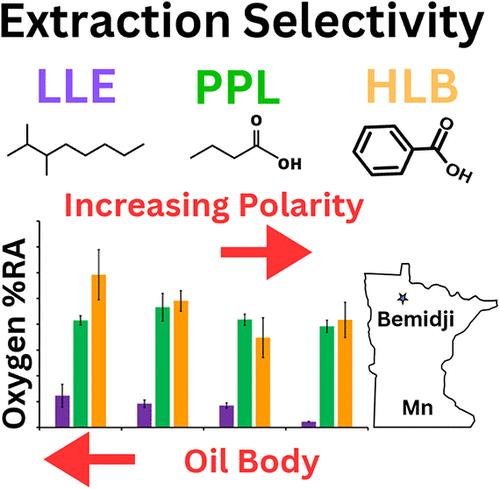Examining the Compositional Selectivity of Hydrocarbon Oxidation Products Using Liquid–Liquid Extraction and Solid-Phase Extraction Techniques
IF 11.3
1区 环境科学与生态学
Q1 ENGINEERING, ENVIRONMENTAL
引用次数: 0
Abstract
The effect of extraction methods on detecting hydrocarbon oxidation products (HOPs) in groundwater remains unclear. HOPs are polar, water-soluble byproducts of petroleum biodegradation. Our previous work showed that liquid–liquid extraction (LLE), a method commonly used in regulatory monitoring, has a significantly lower extraction efficiency for HOPs compared to solid-phase extraction (SPE). In this study, we evaluate the analytical limitations and compositional selectivity of LLE and SPE using groundwater samples from the Bemidji, MN, crude oil spill site. Optical properties were characterized using excitation–emission matrix spectroscopy (EEMs), and a three-component PARAFAC model was validated, showing consistent trends across both extracts and whole water samples. Ultrahigh-resolution mass spectrometry (UHR-MS) revealed that LLE selectively recovered aliphatic-like compounds but underrepresented more polar oxygenated HOPs. In contrast, SPE methods were more effective at isolating highly oxidized compound classes. These differences were consistent across a gradient of contamination. Overall, the LLE was less precise and less representative of polar HOPs, introducing bias in the characterization of HOPs. This study is the first to quantitatively demonstrate the compositional selectivity and analytical bias of LLE versus SPE for HOPs using combined EEM-PARAFAC and UHR-MS techniques, with implications for long-term monitoring and site assessment protocols.

采用液-液萃取和固相萃取技术研究烃类氧化产物的组分选择性
提取方法对地下水中烃类氧化产物(HOPs)检测的影响尚不清楚。啤酒花是石油生物降解的极性水溶性副产物。我们之前的研究表明,液液萃取法(LLE)对啤酒花的萃取效率明显低于固相萃取法(SPE)。在这项研究中,我们利用明尼苏达州Bemidji原油泄漏现场的地下水样本评估了LLE和SPE的分析局限性和组成选择性。利用激发-发射矩阵光谱(EEMs)表征了光学性质,并验证了三组分PARAFAC模型,该模型在提取物和整个水样中显示了一致的趋势。超高分辨率质谱分析(UHR-MS)显示,LLE选择性地回收了脂肪类化合物,但未充分代表更多的极性氧合啤酒花。相比之下,固相萃取法在分离高度氧化的化合物类别方面更有效。这些差异在污染梯度上是一致的。总的来说,LLE的准确性和极性啤酒花的代表性较差,在啤酒花的表征中引入了偏差。该研究首次使用EEM-PARAFAC和UHR-MS联合技术定量地证明了LLE与SPE对啤酒花的组成选择性和分析偏差,这对长期监测和现场评估方案具有重要意义。
本文章由计算机程序翻译,如有差异,请以英文原文为准。
求助全文
约1分钟内获得全文
求助全文
来源期刊

环境科学与技术
环境科学-工程:环境
CiteScore
17.50
自引率
9.60%
发文量
12359
审稿时长
2.8 months
期刊介绍:
Environmental Science & Technology (ES&T) is a co-sponsored academic and technical magazine by the Hubei Provincial Environmental Protection Bureau and the Hubei Provincial Academy of Environmental Sciences.
Environmental Science & Technology (ES&T) holds the status of Chinese core journals, scientific papers source journals of China, Chinese Science Citation Database source journals, and Chinese Academic Journal Comprehensive Evaluation Database source journals. This publication focuses on the academic field of environmental protection, featuring articles related to environmental protection and technical advancements.
 求助内容:
求助内容: 应助结果提醒方式:
应助结果提醒方式:


